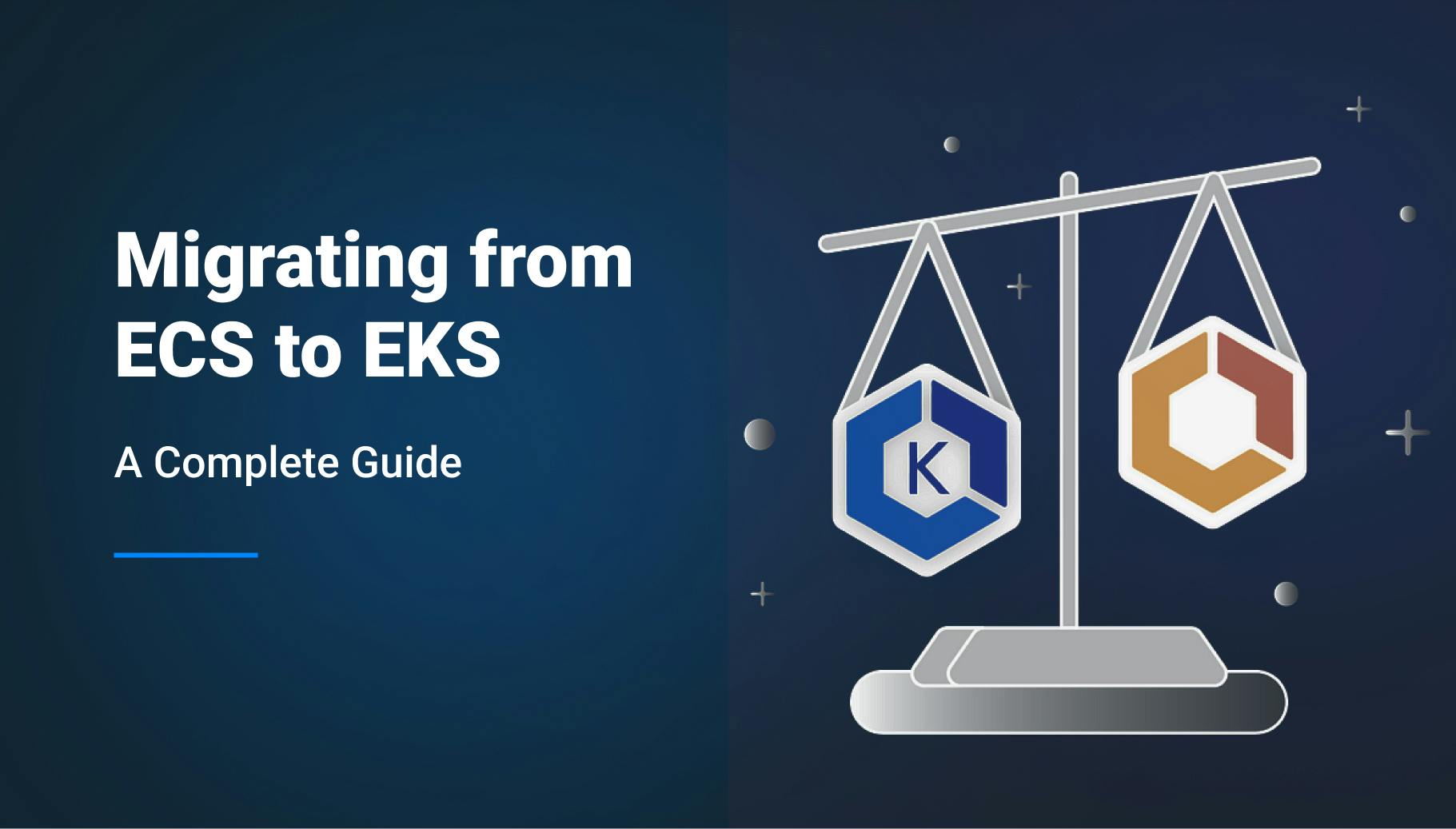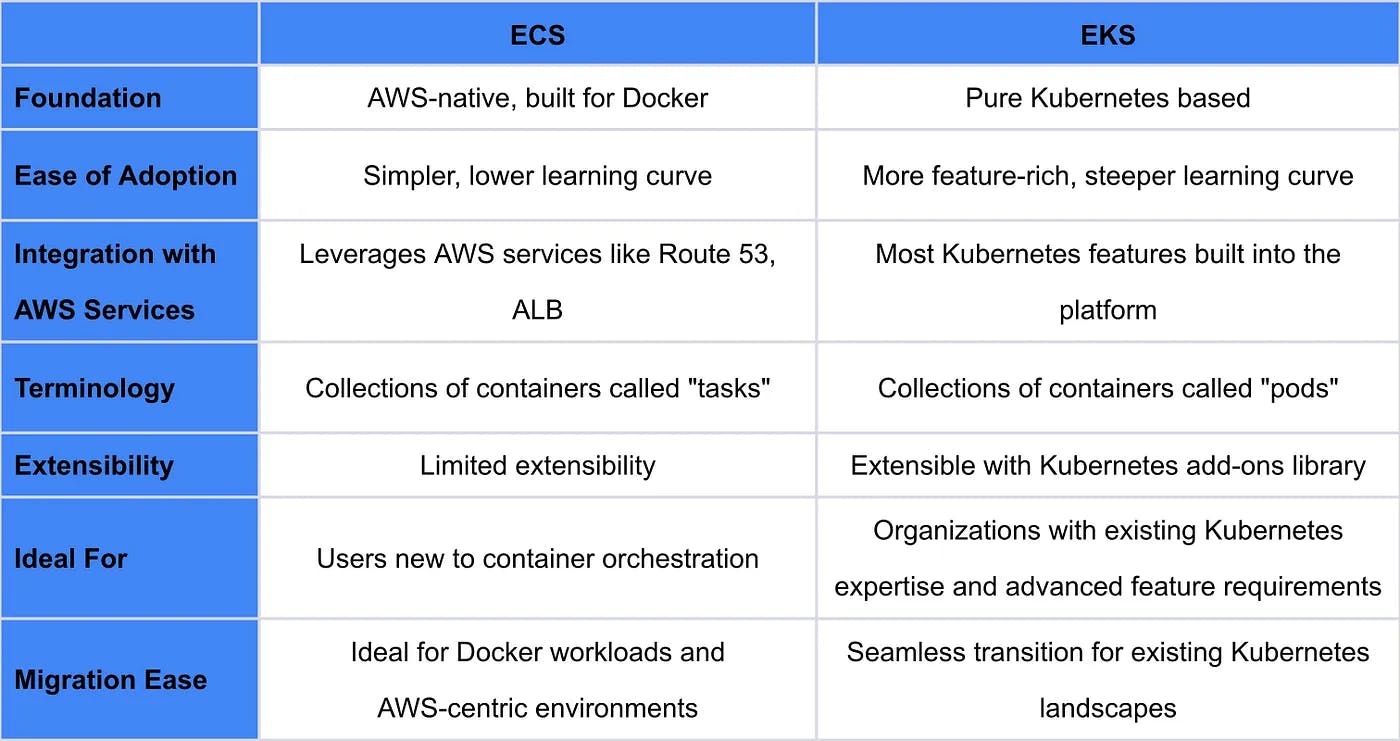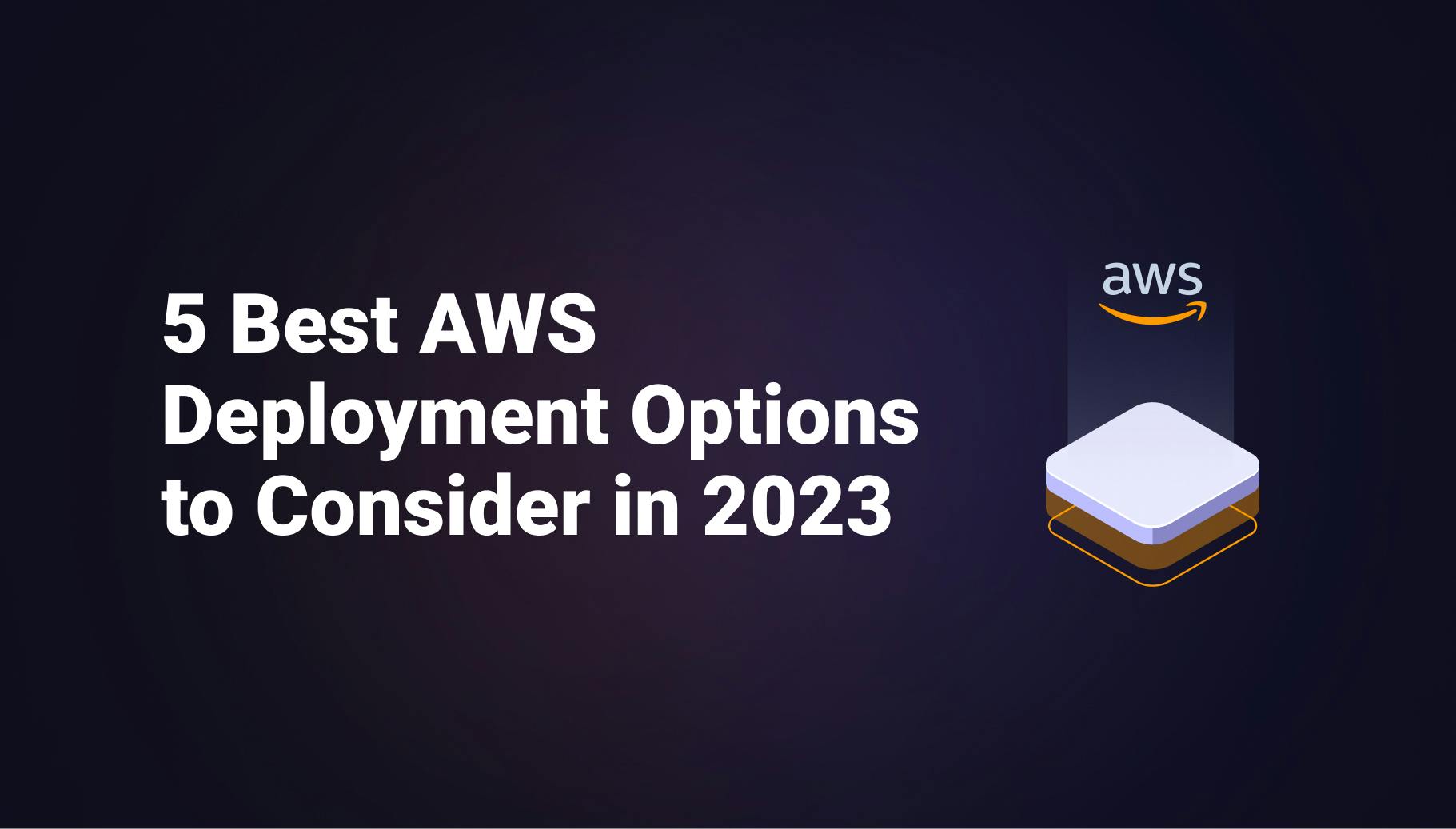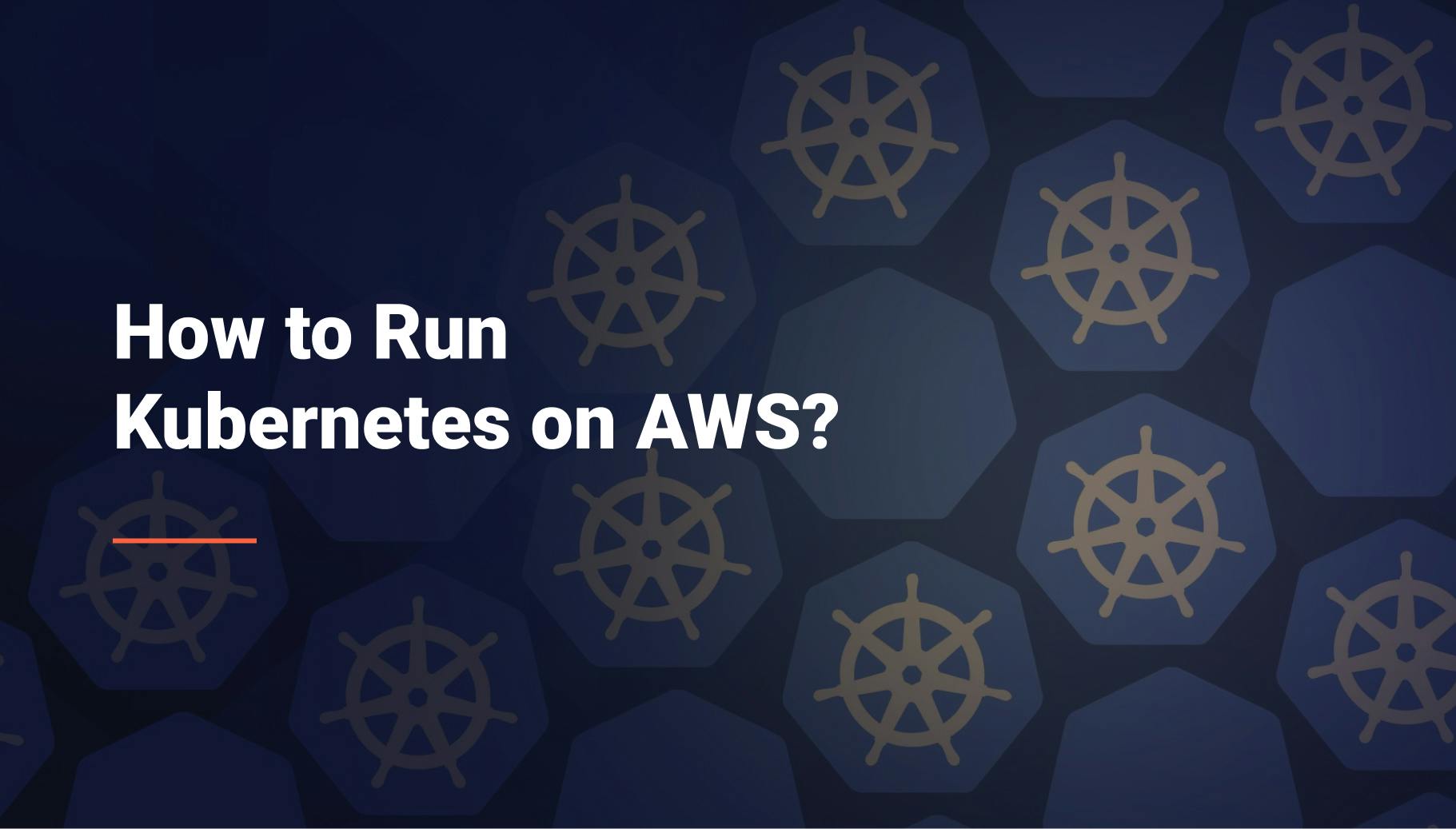Migrating from ECS to EKS: A Complete Guide
Organizations are constantly seeking ways to optimize their IT operations, reduce costs, and improve flexibility. One trend gaining popularity is the shift from Amazon Elastic Container Service (ECS) to Amazon Elastic Kubernetes Service (EKS). This migration is driven by several factors, including the desire for greater flexibility, improved scalability, reduced vendor lock-in, and access to the rich feature set offered by Kubernetes.
This article serves as a comprehensive guide for those intending to migrate from ECS to EKS. I’ll cover a brief comparison of ECS and EKS, discuss their pros and cons, and explain why you might want to consider migrating. I’ll also provide a step-by-step guide on how to migrate, discuss the tools that can facilitate the process, and highlight common pitfalls and how to avoid them. Let’s dive in!

Morgan Perry
May 28, 2024 · 6 min read
#ECS vs EKS: A brief comparison
Although both ECS and EKS are container management services by AWS, however, both differ in functionality and operation. You can check out our article explaining the differences between ECS and EKS. Below is a summary of how ECS and EKS are different from each other.
#ECS: Pros & Cons
ECS Pros:
- Simplicity: ECS is easy to set up and use, especially if you’re already familiar with AWS.
- Seamless AWS Integration: ECS integrates seamlessly with other AWS services, providing a unified and consistent environment.
- Lower Management Overhead: With ECS, AWS handles much of the operational burden, reducing the management overhead for your team.
ECS Cons:
- Limited Flexibility: ECS is less flexible than Kubernetes-based solutions when it comes to configuration and customization.
- Potential Vendor Lock-in: As a proprietary AWS service, moving from ECS to another platform can be challenging.
#EKS: Pros & Cons
EKS Pros:
- Flexibility: EKS supports all Kubernetes features and APIs, giving you more control over your environment.
- Portability: Kubernetes workloads can run anywhere Kubernetes is supported, reducing vendor lock-in.
- Vast Ecosystem of Tools: Kubernetes has a large and active community, resulting in a vast ecosystem of tools and add-ons.
- Better Community Support: Kubernetes has a larger community and better community support compared to ECS.
EKS Pros:
- Higher Complexity: Kubernetes has a steep learning curve and requires a deep understanding of its concepts and components.
- Steeper Learning Curve: EKS requires more upfront learning and setup compared to ECS.
- Potentially Higher Costs: Depending on your usage, EKS can be more expensive than ECS due to additional costs for control plane nodes and other resources.
#From ECS to EKS: Why You Should Migrate
Migrating from ECS to EKS can offer several benefits:
- Overcoming Vendor Lock-in: ECS can lead to vendor lock-in. EKS, powered by Kubernetes, reduces this risk with its compatibility across various environments.
- Enhanced Flexibility and Customization: ECS has limited flexibility. EKS, being Kubernetes-based, offers greater flexibility and customization, supporting all Kubernetes features and APIs.
- Improved Scalability: While ECS has some scalability features, EKS excels in this area with features like Horizontal Pod Autoscaler and Cluster Autoscaler.
- Rich Feature Set: Kubernetes offers advanced features not available in ECS, such as advanced service discovery, ingress control, and native secret management.
- Automation Capabilities: Kubernetes supports declarative configuration and automation, reducing the manual effort required, a common challenge with ECS.

#Migrating from ECS to EKS: Tools to Consider
When migrating from ECS to EKS, several tools can facilitate the process and enhance your container orchestration capabilities. Here are some tools to consider:
#Infrastructure as Code (IaC)
Terraform and AWS CloudFormation are two popular IaC tools that can help you manage your infrastructure more efficiently. They allow you to automate the provisioning and management of your resources, making the migration process smoother and more manageable.
#CI/CD Tools
Jenkins X and Argo CD are robust CI/CD tools that can streamline your deployment pipelines. They can automate the build, test, and deployment processes, ensuring that your applications are always up-to-date and reducing the risk of human error.
#Monitoring and Logging
Monitoring and logging are crucial for maintaining the health and performance of your applications. Tools like Data Dog and the ELK Stack (Elasticsearch, Logstash, Kibana) provide comprehensive monitoring and logging capabilities, giving you insights into your applications and helping you troubleshoot issues more effectively.
#Internal Developer Platform
An internal developer platform can streamline and manage your infrastructure and container management processes. One such tool is Qovery, which simplifies the deployment of your applications on Kubernetes. It integrates with your existing tools and workflows, making it easier to leverage CI tools and manage your resources. During the migration from ECS to EKS, Qovery can play a significant role by providing a unified platform for managing your applications, reducing the complexity of the migration process.
#Migrating from ECS to EKS: A Step-by-Step Guide
#Step 1: Preparation
Start by assessing your current ECS setup. Inventory all services and dependencies to understand the complexity of the migration. Define your migration goals and success criteria. This could include cost savings, improved scalability, or reduced vendor lock-in.
#Step 2: Setting Up EKS Cluster
Create and configure an EKS cluster. This involves setting up the control plane, worker nodes, and networking. Follow best practices for cluster creation and configuration, such as segregating workloads using namespaces, and applying the principle of least privilege to IAM roles.
#Step 3: Migrating Applications
Prepare your container images for deployment to EKS. This may involve updating the base image or making changes to the Dockerfile. Deploy your applications to the EKS cluster using Helm charts or kubectl commands. Set up networking and security configurations, such as ingress rules and network policies.
#Step 4: Testing and Validation
Test your applications to ensure they function correctly in the new environment. Validate performance against your defined success criteria. Troubleshoot common issues, such as connectivity problems or insufficient resource allocation.
#Step 5: Optimization and Maintenance
After migration, optimize resource usage to control costs. This could involve tuning resource requests and limits or implementing auto-scaling. Set up monitoring and logging using tools like CloudWatch or Datadog to gain visibility into your applications and infrastructure.
#From ECS to EKS: Common Pitfalls and How to Avoid Them
#Complexity of Kubernetes Management
Kubernetes is powerful but complex. Managing a Kubernetes cluster can be challenging, especially for teams new to the platform. To mitigate this, use managed services like EKS which handle much of the underlying infrastructure management. Additionally, Kubernetes-native tools can simplify management tasks. For instance, Qovery is a tool that simplifies Kubernetes management, making it easier to deploy and manage applications.
#Configuration and Secret Management
Managing configurations and secrets can be tricky in a Kubernetes environment. Kubernetes provides ConfigMaps and Secrets for secure configuration management. ConfigMaps allows you to decouple configuration artifacts from image content, while Secrets provide a secure way to store sensitive information like passwords and API keys.
#Networking and Service Discovery Challenges
Networking and service discovery are common challenges when migrating to Kubernetes. Kubernetes has built-in service discovery and robust networking capabilities that you can leverage. Use Kubernetes Services for service discovery and Network Policies for controlling network access to your applications.
#Resource Allocation and Optimization
Proper resource allocation is crucial for optimizing performance and cost in Kubernetes. Set resource requests and limits appropriately to ensure efficient resource usage. Kubernetes also provides Horizontal Pod Autoscaler and Vertical Pod Autoscaler for automatic scaling based on resource utilization or other custom metrics.
#Data Persistence Issues
Data persistence can be a challenge in containerized environments. Kubernetes addresses this with Persistent Volumes (PVs) and Persistent Volume Claims (PVCs). PVs and PVCs provide a method for consuming storage resources and support many types of storage systems, ensuring your data persists beyond the lifecycle of individual pods.
#Conclusion
Migrating from ECS to EKS is a significant move that can offer numerous benefits, including overcoming vendor lock-in, enhanced flexibility and customization, improved scalability, a rich feature set, and automation capabilities. However, it’s not a decision to be taken lightly. It requires careful planning, the right tools, and a clear understanding of the steps involved.
This guide has provided a comprehensive overview of the process, from comparing ECS and EKS and understanding their pros and cons to a step-by-step guide on how to migrate, and even how to avoid common pitfalls. Remember, the goal is not just to migrate, but to optimize your operations, reduce costs, and improve flexibility. With the right approach and resources, you can successfully make the transition and reap the benefits of EKS.
Try Qovery for free if you want to adopt a Kubernetes-based platform but without going through the hassles of infrastructure management and complex Kubernetes configurations.
Your Favorite DevOps Automation Platform
Qovery is a DevOps Automation Platform Helping 200+ Organizations To Ship Faster and Eliminate DevOps Hiring Needs,
Try it out now!

Your Favorite DevOps Automation Platform
Qovery is a DevOps Automation Platform Helping 200+ Organizations To Ship Faster and Eliminate DevOps Hiring Needs,
Try it out now!


